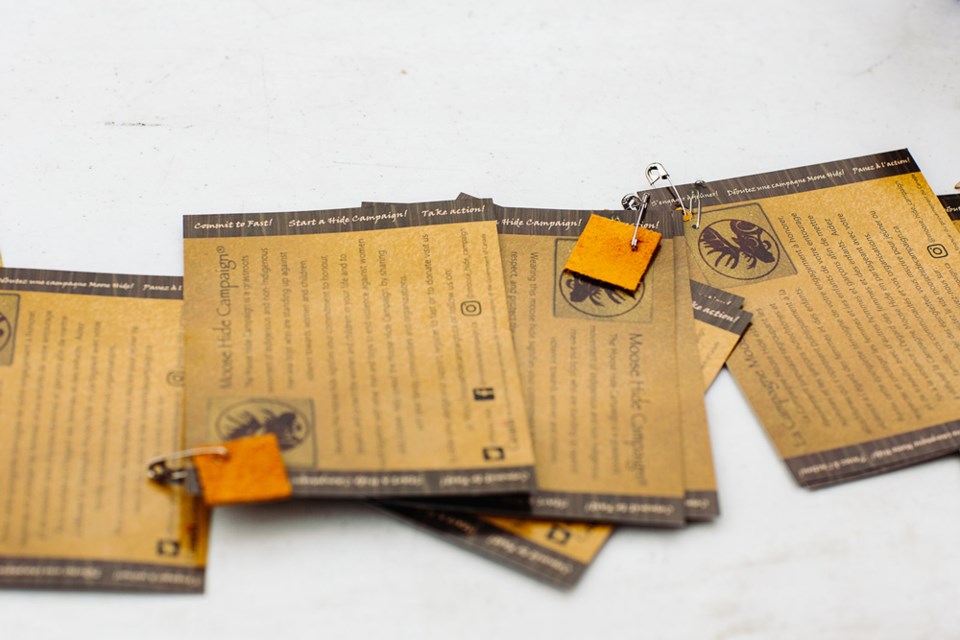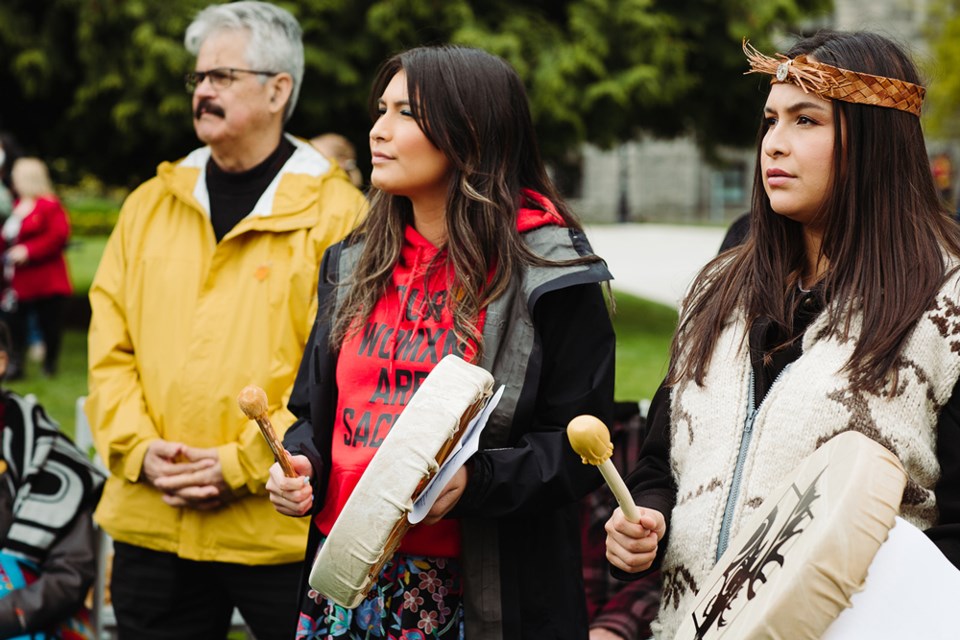Small squares of tawny-toned moose hide are helping to open up vital conversations across sa╣·╝╩┤½├Į around violence against women and girls.
The swatches of hide, wearable as a pin, are a symbol to the world, saying there’s a problem with gender-based violence and it’s something Canadians need to talk more about, says Raven Lacerte, co-founder of the powerful, Indigenous-led grassroots movement known as the .
of all women in sa╣·╝╩┤½├Į will experience an incident of gender-based violence, with a number of Indigenous women and girls impacted.
“People’s lives, women’s lives, are at stake every day,” says Lacerte. “Gender-based violence impacts everyone — no one on the socio-economic scale is immune.”
Making change means bringing people together in a shared effort.
“There’s no unity to this unless we collectively do that together,” she adds.
The moose hide pins are intended to be worn as a sign of commitment by supporters of the campaign’s efforts to ending gender-based violence – speaking up if they witness it and vowing not to have it be part of their lives.
It’s not about calling people out, says Lacerte. It’s about calling people into a space.
The pin also serves to spark conversations — an important part of the campaign, which culminated this year in Moose Hide Campaign Day on May 11.
Grounded in Indigenous ceremony and traditional ways of learning and healing, the primary event was held in Victoria. The day-long ceremony, which started at day break in the Mi’kmaq territory on the Atlantic Coast, included a walk for Reconciliation in Victoria, a plenary session, as well as speeches and online and in-person live workshops with Elders and Knowledge Keepers.
Hundreds more events were anticipated across the country, including in the House of Commons and at other levels of government. The day came to a close with a fast-breaking ceremony and feast. (Participants were invited to fast for the day — a ceremonial practice common in some Indigenous cultures when making personal and collective commitments or doing important work.)
“Violence thrives in the shadows. The Moose Hide Campaign is designed to bring it out of the darkness and into the light,” says Lacerte of the day’s significance.
“The Moose Hide Campaign is something measurable, meaningful and impactful that each and every Canadian can do to be on this journey,” adds Moose Hide Campaign CEO David Stevenson.
Be on the journey

In an effort to bring more focus to the issue, TELUS has committed to a three-year partnership with Moose Hide Campaign to help bring its powerful message across the country. The partnership is a reflection of TELUS’ to Reconciliation, which weaves together four pillars, including connectivity, economic reconciliation, cultural responsiveness and enabling social outcomes by developing and expanding programs that help strengthen communities.
Over the course of three years, TELUS will provide $150,000 and in-kind support to the campaign. The company has also made moose hide pins available to customers in TELUS stores across sa╣·╝╩┤½├Į.
“It’s our privilege at TELUS to partner with the Moose Hide Campaign and provide funding, resources and platforms to support this mission,” says Shazia Zeb Sobani, vice–president of Customer Network Planning at TELUS. “As an organization deeply committed to Reconciliation, this is one way we are responding to the , specifically Call 15, and we sincerely hope that Canadians from coast to coast will join us in making meaningful progress toward change.”
For each moose hide pin produced, there have been at least five conversations about ending gender-based violence – a fact determined by five years of third-party, independent impact measurement. Additionally, for those who wear the moose hide pins, the number is much larger.
“Those conversations are turning into action and real change,” says Lacerte.
The idea behind the campaign came in 2011 when Lacerte, a member of the Lake Babine First Nation and Grizzly Bear Clan, and her father Paul Lacerte, of the Nadleh Whuten Band and member of the Carrier First Nation, were out hunting.
Conversations about gender-based violence were a regular occurrence between the Lacertes.
“As an Indigenous woman, my dad wanted to ensure I knew nothing but love and no violence. It was an urgent need to protect his daughters,” she says.
The father and daughter were in the Carrier and Sekani Territories — an area in central sa╣·╝╩┤½├Į around Prince George bisected by the so-called , a stretch of Highway 16 that has seen numerous Indigenous women go missing or be murdered — when they brought down a moose.
For the Lacertes, the location’s significance sparked a desire to take action.
“We wanted to do something to wipe away those tears and bring hope and love and medicine to those spaces,” says Lacerte.
From the tanned hide of that first moose, Lacerte and her sisters made 25,000 little squares, writing explanations by hand on index cards and handing out the pieces to friends and family, encouraging all to stand up against gender-based violence.
Road to Reconciliation

It took six years to hand out the first million pins. (Synthetic versions are made available for those who don’t want to wear animal hide).
In late April, Lacerte, her sister Sage Lacerte and Stevenson traveled to Ottawa to give out the four-millionth pin, a special edition version covered in intricate beadwork, to Senator Michelle Audette, who was appointed as commissioner for the National Inquiry into Missing and Murdered Indigenous Women and Girls.
“It was so good to hit that milestone,” says Lacerte.
Along with sparking conversations, Lacerte says the hide pins are part of the Reconciliation journey – a small but meaningful step that all Canadians can take.
“It’s four million steps on the road to Reconciliation,” she says.
Moving ahead, the vision is to cross the 10-million-pin mark as the campaign moves ahead with its goal to create online training sessions for organizations, communities and corporations to use as part of their own Reconciliation efforts. The aim is to have the sessions ready for Oct. 1 – the day after.
“The work of decolonization is not just taking pain out and creating justice,” says Stevenson. “It’s just as important to put the love, connection and being good to each other back into the centre.”
For more information about the Moose Hide Campaign, go to .



